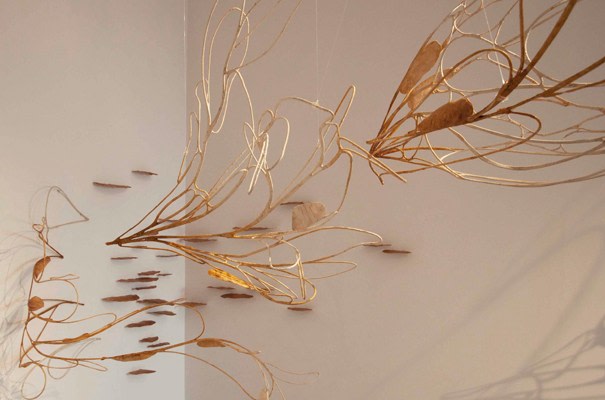
If one were to talk about sculptures, a layman would normally visualize solid forms set on the ground molded into some shape or the other. However, Ranjani Shettar has succeeded in shattering that stereotypical image with her work. Inspired by life and her daily experiences, she resolves problems of weight, balance, space, composition, color and light to bring out the essential character of each material, manipulating how it looks and behaves. In her exhibition, Present Continuous, she tries to capture the essence of change, highlighting the flow of one movement to the next. She says, "In Scent and Sound, I am trying to pin down the source of an emerging tune or the wild scent of a forest flower."
Shettar says her fascination with art began early, but she wasn't sure what kind of art she would create. "I realized it was easier for me to visualize to in three-dimension rather than on a flat surface, so sculpture seemed most suitable," she says. Although her work looks deceivingly simple, it usually takes many years to reach completion. Every idea needs to be well-researched; sometimes there are layers of ideas to work on. Shettar says sights and smells from many years ago could be transformed into sculpture years later; watching people using their hands to create different objects for daily use is fascinating. "I thoroughly enjoy the process of creating (conceptualizing, researching, and implementing). It is a journey on two feet: one foot is the idea and the other material."
Shettar uses traditional and modern crafts to sculpt natural and industrial materials to accentuate the tenuous relationship between the two realms. So far, she has used wood, bronze, stainless steel, muslin, tamarind kernal powder paste and lacqueur, among a host of other materials to create her sculptures. The artist, whose work was showcased in the Museum of Modern Art, San Francisco says she loves experimenting with new materials and techniques. "I like how fingerprints are transferred onto wax or clay. Wood grains transforming into a sculpture; woodcut prints charm me. Patina on various metals is incredibly interesting to me; they signify the time that the metal has lived through." When the suitable material is something she has never worked with, Shettar first researches Lagoon, for instance, attempts to capture the mystery of flowing water. It is a canopy-style installation made up of strings of pear-shaped wooden and glass beads of different sizes lacquered in varying shades of aquamarine and lavender.
Present Continuous is a collection of sculptural works, some mounted on the wall and others hanging from the ceiling, which resonates with an ephemeral beauty found in nature. The dynamic forms and textures of the works seduce with their simplicity, "I take on the journey with curiosity and sometimes find unexpected and interesting turns that end up becoming part of what I make," concludes Shettar.
-Elizabeth Oommen